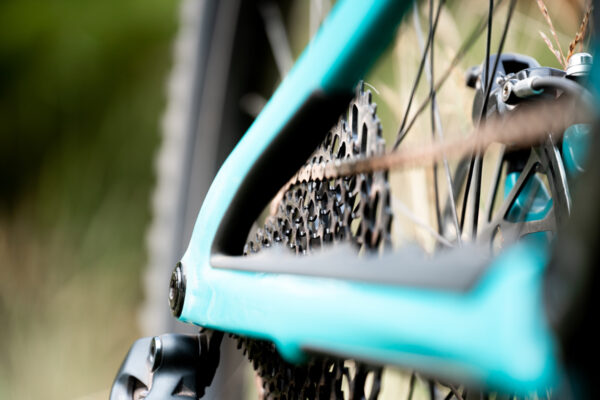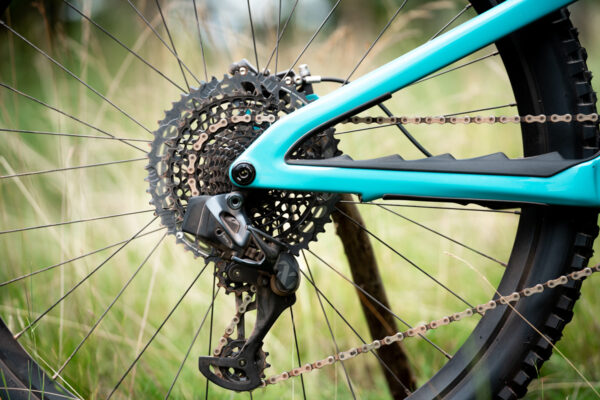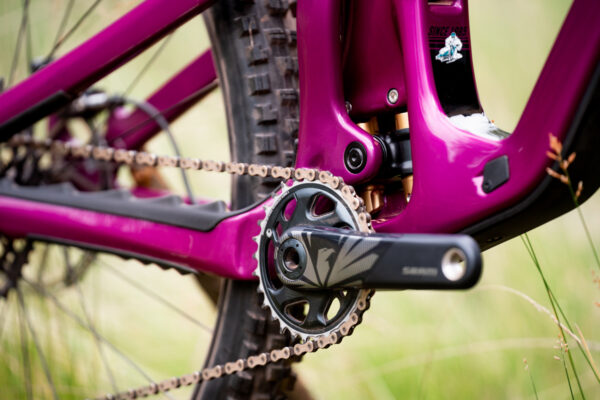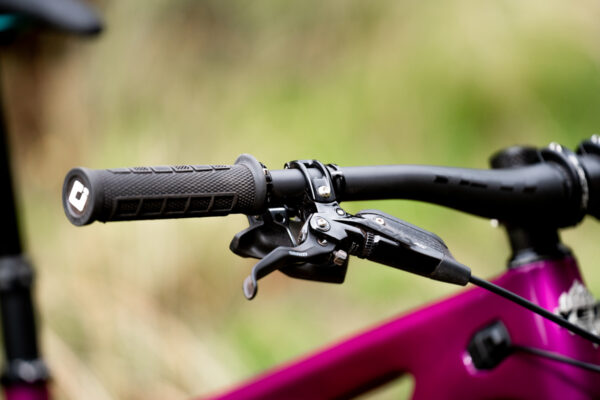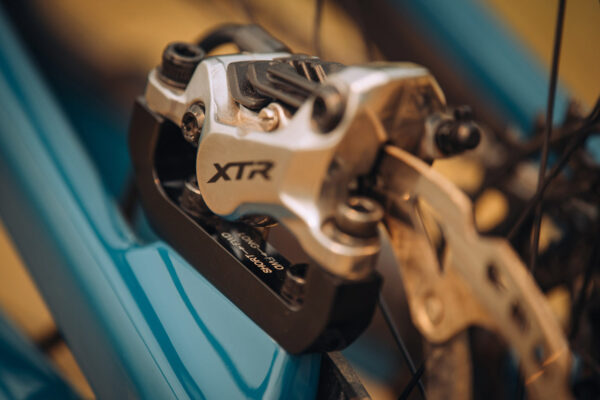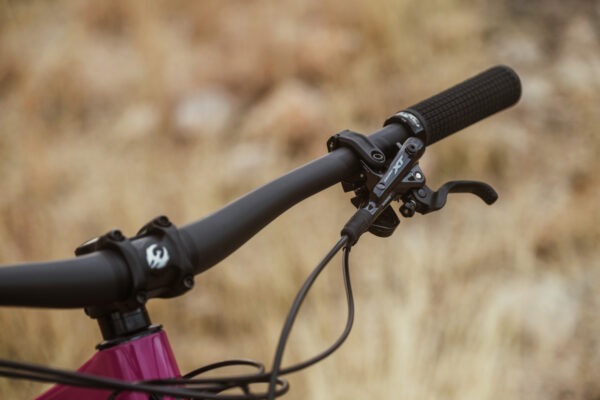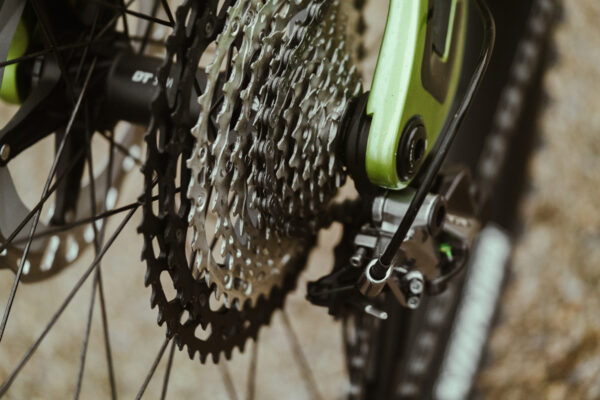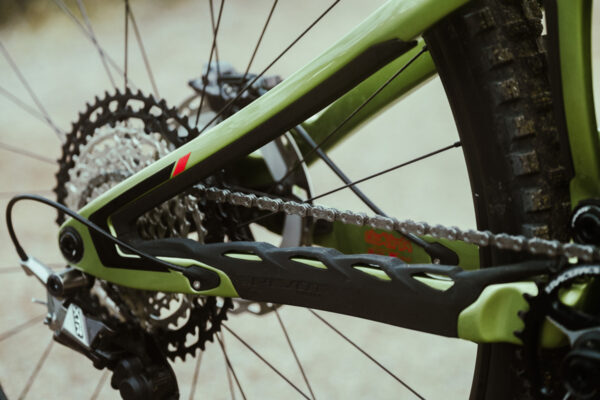
Both SRAM and Shimano offer top-of-the-line components for the best mountain and gravel bikes on the market.
If you’re looking for the footnotes: SRAM vs. Shimano has been the proverbial “Coke-Pepsi” test in mountain and gravel bike components for decades. In our updated product line comparison, we include more information about their respective braking systems. For good reason: there are significant differences. Although you can accomplish the same tasks on equipment from either brand, your familiarity or preference may make you more efficient with one over the other. And with an avalanche of new electronic product releases in the past year, answering the question “Should I ride SRAM or Shimano?” can be complex.
The Product Breakdown
Both companies offer full groupset and drivetrain systems that go head-to-head in competition, from mid-level to World Cup race quality. Also, both brands have pushed further into diversifying electronic technology (and both still use naming conventions that start with X) so things can get a little confusing. The following tables are our cheat sheets for understanding how the product offerings stack up:
| Shimano | SRAM | ||||
| Mechanical | Electronic | Mechanical | Electronic | Electronic/T-Type | |
| MTB | |||||
| Entry Level | Deore | NX/SX | |||
| Mid Level | SLX | GX | GX Eagle AXS | Eagle Transmission GX | |
| High End | Deore XT | X01 | X01 Eagle AXS | Eagle Transmission GX | |
| Top of the Line | XTR | XTR Di2 | XX1 | XX1 Eagle AXS | Eagle Transmission GX |
| Gravel | |||||
| Entry Level | Apex | Apex eTap AXS | |||
| Mid Level | GRX 600 | Rival | Rival eTap AXS | ||
| High End | GRX 800 | GRX Di2 | Force | Force eTap AXS | |
| Top of the Line | GRX 822 | Red | Red eTap AXS | ||
| E-MTB | Deore XT Di2 | Eagle Powertrain | |||
| Shimano | |||
| Mechanical | Electronic | ||
| MTB | |||
| Entry Level | Deore | ||
| Mid Level | SLX | ||
| High End | Deore XT | ||
| Top of the Line | XTR | XTR Di2 | |
| SRAM | |||
| Mechanical | Electronic | Electronic/T-Type | |
| Entry Level | NX/SX | ||
| Mid Level | GX | GX Eagle AXS |
Eagle Transmission GX
|
| High End | X01 | X01 Eagle AXS |
Eagle Transmission GX
|
| Top of the Line | XX1 | XX1 Eagle AXS |
Eagle Transmission GX
|
| Shimano | |||
| Gravel | |||
| Entry Level | |||
| Mid Level | GRX 600 | ||
| High End | GRX 800 | GRX Di2 | |
| Top of the Line | GRX 822 | ||
| SRAM | |||
| Mechanical | Electronic | ||
| Entry Level | Apex | Apex eTap AXS | |
| Mid Level | Rival | Rival eTap AXS | |
| High End | Force | Force eTap AXS | |
| Top of the Line | Red | Red eTap AXS | |
| Shimano | |||
| Mechanical | Electronic | ||
| E-MTB | Deore XT Di2 | ||
| SRAM | |||
| Mechanical | Electronic | Electronic/T-Type | |
| Eagle Powertrain | |||
SRAM: AXS, Transmission, and XPLR
AXS is SRAM’s proprietary component integration system that connects electronic bicycle components and software; the shifter and derailleur communicate via bluetooth. AXS-enabled components pair to a mobile app that serves as a hub for connecting, personalizing, and monitoring your SRAM electronic components.
Transmission is SRAM’s proprietary mountain bike shifting component (the derailleur), featuring a “hangerless” design that mounts directly to your bike. The design eliminates the variability of adjustment and failures of derailleur hangers. The Eagle Transmission, or “T-Type,” derailleur is also referred to as UDH (Universal Derailleur Hanger) compatible, and all Transmissions are AXS components. As of this blog publication, there are 210 bike models (including all the brands at Sports Garage) that have designed UDH-compatible rear triangles, which accept a full mount Eagle Transmission derailleur, that shift electronically via the AXS component integration system.
XPLR is SRAM’s proprietary wide range 1x gravel cassette and derailleur combination. This 10-44t cassette is not the same as your mountain bike wide range 1x cassette—XPLR is specific to drop bar applications, and is available on all electronic AXS group sets, and mechanical Apex.
Would you like a side of focaccia with that alphabet soup?
Our Thoughts
The experience of riding SRAM technology and Shimano technology is pretty close these days, with only small details differentiating the two.
Shimano drivetrains have a little more engaged feel at the shifter, but the chain gradually transitions from one gear to the next, making for a very smooth shift, hence their “Hyperglide” branding. Sometimes it’s so smooth it’s hard to tell if you actually changed gears besides the fact that it is suddenly easier to pedal. It is nice to experience that smooth shifting without worrying about your battery dying, though that is only an advantage on non-Di2 systems (Di2 is Shimano’s electronic shifting).
SRAM tends to have a lighter feel at the shift lever, but the chain has a positive shift, jumping on to the next cog all at once. You will know you shifted with a SRAM drivetrain. T-Type (Transmission) derailleurs have definitely increased shifting smoothness; in some of our riding experience we think it’s on par with Shimano. Transmissions are hands down the smoothest shifting under load, whether you’re moving up or down the cassette. The Transmission downside? Slower shifting. It’s noticeable.
To us, the biggest difference is in the brakes. Shimano brakes are known for having more power but less modulation—great for stopping before you run off the trail, but not as easy to scrub just a little speed before a corner. SRAM brakes have a little less power but have great modulation—perfect for slowing down without making the tire skid, but they can feel a little “soft” if you’re accustomed to stop-on-a-dime Shimano 4 piston power. Both can work well but require a different touch. We are looking forward to spending more time on the recently released SRAM Maven brakes, which the brand bills as “Extreme Duty” and compares to Shimano’s Saint brakes. Here at Sports Garage we think SRAM vs. Shimano vs. Hayes vs. Hope is worth an extra conversation, so keep an eye out for more of our thoughts on this.
| Brakes | ||
| Shimano | SRAM | |
| Entry Level | Deore | DB8 |
| Mid Level | SLX | Level |
| High End | Deore XT | G2 |
| Top of the Line | XTR | Code |
| Extra Duty | Saint | Maven |
So, How to Choose?
If you’re a research-driven type of rider, chances are you’ve already spent several hours on “SRAM vs. Shimano” reviews. Research is a great jumping off point for either making your decision or asking more questions! Two rules of thumb we recommend when making your product selection:
- Demo a drivetrain: If you haven’t experienced electronic shifting in action, consider taking out a demo—even if the bike isn’t the model you’re interested in buying, demoing a drivetrain can help you make a more informed decision.
- Compare products in the same quality range: If you’re looking at a bike equipped with Shimano XT technology, the “apples to apples” comparison is a bike equipped with SRAM Eagle Transmission X01. Yes, SRAM’s elimination of new mechanical X01 drivetrains has made this comparison more complex, but in the SRAM vs. Shimano debate, this is where we’re at.
Sports Garage Demo Bikes Equipped with SRAM AXS T-Type Transmissions
- Pivot Mach 4 SL (Small, Medium, Large)
- Pivot Switchblade (Medium, Large)
- Yeti SB120 (Large)
Sports Garage Predictions
The move to electronic components is not slowing down, and we predict more apps and more data integrations will seep into our riding experience. The SRAM AXS app already integrates with Hammerhead, Wahoo, and Garmin bike computers. Although related to Shimano motors (that’s an entirely different article), not drivetrains, Shimano’s E-Tube Project app allows for preset profiles for your e-MTB riding. Want a setting for “gnarly stuff” and a setting for “smooth stuff”? There’s an app for that.
We predict that Shimano will retain a competitive position with reliably high-quality mechanical drivetrains. There is some comfort and beauty in the relative simplicity of their catalog
Seemingly a contrary perspective, we also predict that SRAM will keep an advantage in the high end of the marketplace, and their innovation in drivetrains will have a positive impact on the adoption of their suspension technology. More T-Type RockShox builds in the catalog? We think so.
SRAM History in 60 Seconds
When it comes to bike history, American-founded SRAM is legendary for the invention of the Grip Shift. Introduced in 1988, this “twist shift” shifter elevated clunky shifting technology from the downtube to the handlebars. While the Grip Shift put SRAM on the map, it wasn’t until the introduction of their derailleur and MTB Grip Shift entered the scene that SRAM became a mainstay in the cycling industry. The XO1 rear derailleur was launched in 2001, and the XX1 groupset followed in 2012—completing the family we still see offered on mountain and gravel bikes today. Looking to the future, SRAM is expanding into new territories: They recently announced an exciting partnership with the New York Yacht Club for the 37th America’s Cup.
Shimano History in 60 Seconds
Hailing from Japan, Shimano’s roots reach way back to 1921 with the development of a new-and-improved bicycle freewheel. This remained the company’s bread and butter for 35 years, until they introduced an external speed changer followed by an internal one (a revolutionary 3-speed hub). It was in the ’70s that Shimano announced their unique foray into the fishing industry, making use of this new technology on reels. Their shifting tech, called Positron, followed in 1974. Fast forward to the early ’80s, and a familiar name comes to life: the entry-level Deore XT groupset. XTR followed, with a gravel-specific groupset coming on the market in 2019. This steady march toward progress over the past 100 years has kept Shimano in the running as one of the best options for components available today.
Sports Garage Predictions
The move to electronic components is not slowing down, and we predict more apps and more data integrations will seep into our riding experience. The SRAM AXS app already integrates with Hammerhead, Wahoo, and Garmin bike computers. Although related to Shimano motors (that’s an entirely different article), not drivetrains, Shimano’s E-Tube Project app allows for preset profiles for your e-MTB riding. Want a setting for “gnarly stuff” and a setting for “smooth stuff”? There’s an app for that.
We predict that Shimano will retain a competitive position with reliably high-quality mechanical drivetrains. There is some comfort and beauty in the relative simplicity of their catalog
Seemingly a contrary perspective, we also predict that SRAM will keep an advantage in the high end of the marketplace, and their innovation in drivetrains will have a positive impact on the adoption of their suspension technology. More T-Type RockShox builds in the catalog? We think so.
SRAM History in 60 Seconds
When it comes to bike history, American-founded SRAM is legendary for the invention of the Grip Shift. Introduced in 1988, this “twist shift” shifter elevated clunky shifting technology from the downtube to the handlebars. While the Grip Shift put SRAM on the map, it wasn’t until the introduction of their derailleur and MTB Grip Shift entered the scene that SRAM became a mainstay in the cycling industry. The XO1 rear derailleur was launched in 2001, and the XX1 groupset followed in 2012—completing the family we still see offered on mountain and gravel bikes today. Looking to the future, SRAM is expanding into new territories: They recently announced an exciting partnership with the New York Yacht Club for the 37th America’s Cup.
Shimano History in 60 Seconds
Hailing from Japan, Shimano’s roots reach way back to 1921 with the development of a new-and-improved bicycle freewheel. This remained the company’s bread and butter for 35 years, until they introduced an external speed changer followed by an internal one (a revolutionary 3-speed hub). It was in the ’70s that Shimano announced their unique foray into the fishing industry, making use of this new technology on reels. Their shifting tech, called Positron, followed in 1974. Fast forward to the early ’80s, and a familiar name comes to life: the entry-level Deore XT groupset. XTR followed, with a gravel-specific groupset coming on the market in 2019. This steady march toward progress over the past 100 years has kept Shimano in the running as one of the best options for components available today.

